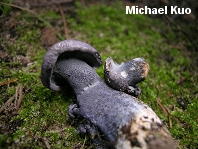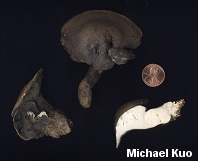| Major Groups > Polypores > Stemmed, Pale-Fleshed > Albatrellus caeruleoporus |

|
Albatrellus caeruleoporus [ Basidiomycetes > Polyporales > Albatrellaceae > Albatrellus . . . ] by Michael Kuo In theory, there are two North American Albatrellus species that are blue: the eastern Albatrellus caeruleoporus (primarily associated with hemlock; pore surface blue; clamp connections absent) and the western Albatrellus flettii (associated with various conifers; pore surface white; clamp connections present). However, Albatrellus confluens populations in the Rocky Mountains sometimes demonstrate bluish colors, as do occasional Midwestern collections of Albatrellus cristatus--and West-Coast collectors regularly find Albatrellus flettii with a blue, rather than white, pore surface. Truth be told, the genus Albatrellus is in dire need of a revision based on DNA and ecological factors, and many of the dividing lines between species as they are currently defined are blurry. Note: This mushroom's beautiful colors fade quickly, and it is frequently found looking like the drab specimens illustrated lower right, which were scanned several days and hundreds of miles after being collected. Description: Ecology: Mycorrhizal with eastern hemlock and perhaps other conifers; often appearing in low, wet woods; growing alone or gregariously; summer and fall; fairly widely distributed in eastern North America wherever hemlock occurs. Cap: 2-7 cm across; more or less circular in outline; loosely convex, flat, or irregular; occasionally fused; dry; smooth, finely velvety, or with tiny scales in patches; blue, gray, or grayish blue, becoming brown, brownish, or orangish brown. Pore Surface: Descending the stem; pale blue or gray, becoming grayish or brownish; 2-3 angular pores per mm; tubes to 5 mm deep. Stem: 2.5-7 cm long; up to 2 cm wide; sometimes a little off-center; blue, discoloring to grayish or brownish with age; smooth or rugged. Flesh: Whitish; fairly soft when fresh. Odor and Taste: Odor not distinctive; taste mild or slightly acrid. Spore Print: White. Dried Specimens: Often developing reddish or orange colors. Microscopic Features: Spores 4-6 x 3-5 µ; smooth; broadly elliptical or subglobose; inamyloid. Gloeoplerous hyphae absent. Clamp connections absent. REFERENCES: (Peck) Pouzar, 1966. (Saccardo, 1888; Overholts, 1953; Smith, Smith & Weber, 1981; Arora, 1986; Gilbertson & Ryvarden, 1986; Phillips, 1991/2005; Lincoff, 1992; Barron, 1999; Roody, 2003; McNeil, 2006.) Herb. Kuo 09180501. This site contains no information about the edibility or toxicity of mushrooms. |
© MushroomExpert.Com |
|
Cite this page as: Kuo, M. (2007, April). Albatrellus caeruleoporus. Retrieved from the MushroomExpert.Com Web site: http://www.mushroomexpert.com/albatrellus_caeruleoporus.html |

